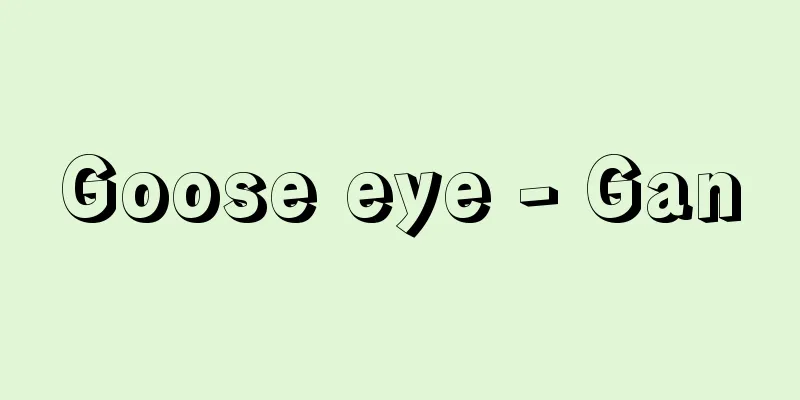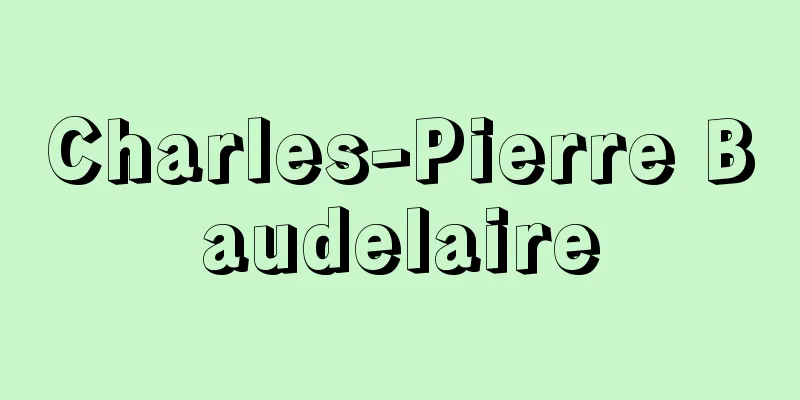Genius - sugar beet

|
A genius is someone who demonstrates abilities and talents far superior to those of ordinary people, such as by engaging in highly creative activities or achieving outstanding social achievements. There are two ways of looking at this ability. The first is that the difference between a genius and an ordinary person is merely quantitative. The second is that the difference is qualitative. [Tamotsu Fujinaga] First PositionIn psychology up until the 1950s, the theory of intelligence unification, which holds that all intellectual achievements are the product of intelligence, was believed against the backdrop of the practical success of intelligence tests and the progress of their research, and the view that geniuses are people with extremely high IQs was strong. For example, intelligence test researcher Terman claims that the frequency of people with an IQ of 140 or higher is only 0.25%, and that these people are geniuses. He conducted a long-term follow-up study of gifted children in California with an IQ of 140 or higher, and showed that the majority of these children's IQs remained unchanged in later life, and they excelled in academic ability and academic background, and also had high social status and income. However, there were also cases where people with high IQs did not achieve social success due to emotional instability. Furthermore, few of these gifted children achieved the expected creative achievements. Ironically, two Nobel Prize winners emerged from among the children who were not included in Terman's group of high intelligence. The Termans first called highly intelligent children geniuses, but later changed the term to gifted children. Furthermore, when the academic performance of people who are said to be geniuses was examined, it was found that, as is well known from the examples of Edison and Einstein, there were rather a small number of so-called honor students who got good grades in all subjects (Kant was a good example), and while they showed enthusiasm and talent in certain subjects, there were many cases where the academic performance was noticeably disproportionate. From this, it is clear that high IQ and academic performance alone are not the only factors that guarantee success, that personality factors also play a large role, that geniuses are not necessarily good at school, and that geniuses and high IQs are not the same. Since the 1960s, research on creativity tests has become more active based on the criticism that intelligence tests can only measure a part of intelligence. What is interesting is that there is a gap between the results of intelligence tests and creativity tests, and the two are not necessarily parallel. It is still unresolved whether creativity tests can predict creative achievement, but at least the theory that IQs are the continuum between normal people and geniuses has almost lost credibility. Another position on the continuity theory is the effort theory, or the motivation to learn theory, symbolized by the words of the French naturalist Buffon, "Genius is another name for long-term patience." It goes without saying that the achievement of genius requires the acquisition of advanced knowledge and skills as a preparatory step, as well as long-term concentration on a specific task. However, as shown in various studies on creativity, the focus of a creator is a pure desire to explore, not necessarily a desire to achieve success. In this respect, something different from the utilitarian motivation that is central to general motivation should be seen as supporting the achievements of geniuses, and here too the difference between ordinary people and geniuses is on the qualitative rather than quantitative level. [Tamotsu Fujinaga] Second PositionThe position emphasizing the second qualitative difference originates from Lombroso's theory of genius as madness, and is common among psychiatrists. This idea is naturally linked to the hereditary theory that genius is due to special genetic factors. According to German psychiatrist Wilhelm Lange Eichbaum (1875-1949), among 300-400 geniuses from ancient times, the proportion of those who showed a mental illness at least once in their lives reached 12-13%, which is abnormally higher than the average population of 0.5%. Furthermore, if 35 of the highest geniuses were selected, the proportion of those who were mentally ill reached 40%, making the connection with pathology indisputable. Kretschmer also discussed the connection between human talent and genetic constitution, and distinguished between geniuses with an elongated constitution - schizoid temperament, such as Kant, and geniuses with an obese constitution - manic-depressive temperament, such as Alexander von Humboldt. Freud also argued that Shakespeare, for example, repressed a very deep Oedipus complex, which manifested itself in his themes and resonated with many people. This does not emphasize heredity, but it can be said to be a kind of madness theory in that it claims that a specific pathological mentality of a specific individual produces creativity. These theories opened up a research field called pathography, which seeks to trace the onset and progression of mental symptoms in geniuses and to determine how they relate to creative activity. Jaspers' analysis of Strindberg and Van Gogh is famous as a classic in this field, and in Japan, research on various writers such as Natsume Soseki, Shimazaki Toson, and Miyazawa Kenji has become popular since the 1950s. However, pathography up to this time was based on the traditional view that endogenous mental illnesses were divided into two major types, schizophrenia and manic-depressive disorder, but with the development of behavioral genetics and other fields, these two are no longer necessarily viewed as separate. In addition, pathography data are episodic and difficult to call strict diagnosis. For these reasons, the connection between genius and insanity was once considered to be unfounded, but the discovery of new data has led to a renewed reconsideration of this idea, and the relationship between manic depression and literary talent is being examined using empirical methods. Furthermore, advances in creativity research have revealed that genius is a complex and diverse entity that cannot be reduced to a single simple factor. For example, a period of concentrated effort is required before creativity, and seemingly unrelated factors such as aesthetic sensitivity also seem to be important. However, the current trend in many social and human sciences, especially in natural sciences, is strongly oriented toward big science, and team achievements are becoming more mainstream than individual achievements. Research topics themselves are becoming more common, and multiple teams are always competing with each other by a paper-thin margin, so it is difficult to evaluate whether a achievement is truly groundbreaking just because someone has reached the goal one step ahead of others. In the future, achievements worthy of the name of genius will probably tend to appear only in fields that depend heavily on individual talent, such as philosophy, mathematics, literature, painting, music, and sports. [Tamotsu Fujinaga] Savant syndrome and multiple intelligencesAn interesting insight into the genetic disposition of geniuses can be found in research on the savant syndrome (the term originally comes from the French psychiatric term "idiot savant." In Japanese, it was once translated as "idiot genius." Currently, it is referred to as savant syndrome, omitting the discriminatory "idiot"). The savant syndrome refers to cases in which a person exhibits exceptional abilities in a specific field despite being intellectually retarded in the general sense. There are various areas of talent, such as the ability to count dates and numbers, superhuman memory, acute perceptual abilities, and painting abilities, but the most well-known example is musical ability (the example of Kiyoshi Yamashita (1922-1971) is well known in Japan for his painting). For example, during the American Civil War, a poor black female slave was sold to Colonel Beaton with a son, who was mentally retarded, had a vocabulary of less than 100 words, and was blind. He was named Thomas Green Beaton, and was interested in the piano lessons that the colonel's daughter was taking. He was discovered playing songs that he had heard and learned at the age of four, without any training. Since then, the colonel has focused on teaching Tom, and as a result, he has a repertoire of 5,000 songs and has toured all over the United States. Tom was able to accurately reproduce songs and songs that he had heard only once, and he also showed a talent for improvisation. Similar cases of paranormal abilities have been reported since then. Savant syndrome is said to occur frequently in children with autistic symptoms. Although its mechanism has not yet been elucidated, it is suggested that the aforementioned specific skills are independent of general intelligence and each constitutes its own area of ability (module). American educational psychologist Howard Gardner (1943- ) proposed the theory of multiple intelligences (MI) as a synthesis of savant syndrome and other findings, in contrast to the conventional emphasis on general intelligence, which states that there are eight independent intelligences: linguistic, logical/mathematical, spatial, musical, bodily/motor, introspective (personal), interpersonal, and natural history. These abilities are said to emerge relatively early. Furthermore, he argues that traditional school education has fallen into a bias toward only the first two, and advocates the emphasis on individual abilities and individual education. In the United States, experimental schools for multiple intelligences have been established, and combined with gifted education in China, it may be possible to open the way to discover and develop new talents. [Tamotsu Fujinaga] Developmental disorders and geniusesKretschmer once argued that as positivism became mainstream in academia, a shift was observed from schizoid-elongated geniuses who favor abstract theories to manic-depressive-obese geniuses who value concreteness and proof. It is interesting to note that the quality and type of talent required by society changes with the times and cultural environment. In the 1990s, with the rapid increase in so-called developmental disorders, the issue of unique talents seen in savant syndrome was expanded further, and the relationship between developmental disorders and extraordinary abilities and geniuses is attracting attention. Autism, a typical developmental disorder, is often accompanied by some kind of intellectual retardation, including language delay, and the special talents that appear are limited to specific areas like those seen in savants, and it is common for people with autism to show many defects in their daily lives. In contrast, Asperger syndrome (group), which was discovered in the 1940s at the same time as autism, shows similar social and communication disabilities but does not show intellectual retardation. Following this, high-functioning autism was also named, and the scope of autism-like disorders gradually expanded to include terms such as pervasive developmental disorder (PDD) and autism spectrum disorder, but learning disabilities (LD) and attention deficit hyperactivity disorder (ADHD) were also added as similar disorders. Both the terminology and concepts show the chaos of the transition period, but the question is to what extent developmental disorders in this broad sense have increased. Since the old statistics do not have the terminology itself, there is no way to make a strict comparison, but many researchers say that the increase cannot be denied. The figures vary depending on the definition and the method of investigation, but in Japan, some say that the prevalence reaches 2-3% among school-age children, and the results of the Ministry of Education, Culture, Sports, Science and Technology survey are higher than that. One reason for the increase is that, as mentioned above, symptoms that were previously considered unrelated have come to be included in developmental disorders, and that even people who show minor symptoms are easily labeled as having developmental disorders as a kind of fad. Other essential reasons and causes remain a matter of speculation, such as hormonal abnormalities, but this is probably due to the background that developmental disorder characteristics are being transformed into new values in society. For example, it is believed that characteristics that were not considered desirable in the previous generation are becoming more apparent and stronger due to the change in social conditions, such as people who are passionate about a certain job or field but have no interest in anything else, and who have many flaws in things other than what they are good at, becoming successful. Perhaps because of this background, the relationship between developmental disorders and supernatural abilities is becoming a topic in modern pathography. A typical example is Einstein, who had severe language delays in his early childhood and failed the university entrance exam because he did not want to learn classical languages. Even as an adult, he still wrote in mirror writing (writing in which the left and right are reversed). There are stories of him becoming absorbed in thought and even seeing his family as shadow puppets. Einstein also did not use language as a tool for thinking, but relied on visual representations. Mathematical genius and language disorders may be inextricably linked. These examples suggest that abnormal talents are only born on some kind of bias. In American gifted education, children who have both supernatural abilities and language disorders are called twice exceptional (2E for short). This concept takes the idea of old pathography a step further and considers that there is an inevitable relationship between disabilities and supernatural abilities. [Tamotsu Fujinaga] "Genius" by Lombroso, translated by Tsuji Jun (1926, Shunjusha)" ▽ "Strindberg and Van Gogh" by Jaspers, translated by Murakami Hitoshi (1952, Sogensha)" ▽ "Traces of Soseki's Illness" by Chitani Shichiro (1963, Keiso Shobo)" ▽ "Modern Esprit: Psychopathology of Genius" edited by Fukushima Akira (1982, Shibundo) " ▽ "Kretschmer's Thought: A Holistic Theory of Mind and Body" edited by Fukuya Takehito and Nabeta Yasutaka (1986, Yuhikaku) " ▽ "What is Genius?" by G. Tonelli et al., translated by Hosoi Yusuke et al. (1987, Heibonsha) " ▽ "Why Do They Show Genius Abilities? The Wonders of Savant Syndrome" by Darold A. Treffert, translated by Takahashi Kenji (1990, Soshisha)" ▽ "A New Theory of Genius: An Approach from Education" by Furuya Masao (1996, Minerva Shobo)" ▽ "Talent Development in Autism: The Link Between Autism and Genius" by Temple Grandin, translated by Cunningham Hisako (1997, Gakken)" ▽ "Genius: The Secret of Creativity" by W. Lange Eichbaum, translated by Shimazaki Toshiki and Takahashi Yoshio (2000, Misuzu Shobo)" ▽ "How Genius Scientists are Born: Is Creativity Serendipity?" by Richard P. Brennan, translated by Oba Ichiro and Muroya Shin (2001, Maruzen) ▽ "MI: A Theory of Multiple Intelligences to Make the Most of Individuality" by Howard Gardner, translated by Matsumura Nobutaka (2001, Shinyosha) ▽ "Genius and Disease" by Nestor Lujan, edited by Nikkei Medical (2002, Nikkei BP) ▽ "Biographies of Mathematical Geniuses - Takeuchi Hitoshi, the World of Knowledge and Impression" by Takeuchi Hitoshi (2002, Newton Press) ▽ "The Evolution of Genius and Schizophrenia" by David Horrobin, translated by Kanazawa Yasuko (2002, Shinchosha) ▽ "Einstein and Picasso: How Two Geniuses Perceived Time and Space" by Arthur I. Miller, translated by Matsuura Shunsuke (2002, TBS Britannica) ▽ "The Brain Science of Genius" by Andreasen, translated by Nagano Takashi and Ota Hidehiko (2007, Seidosha) ▽ "Genius and Developmental Disorders" by Oka Minami (Kodansha, 2010)" ▽ "The Psychology of Genius" by Ernst Kretschmer, translated by Uchimura Yuji (Iwanami Bunko)" ▽ "Genius: A Pathography of Creation" by Fukushima Akira (Kodansha Gendai Shinsho)" ▽ "Genius" by Franz Brentano, translated by Shinoda Hideo (Iwanami Bunko)" ▽ "The Private Lives of Geniuses Depicted in Episodes by Chronology" by Gerhard Prause, translated by Azechika Tsukasa and Akane Yoko (Bunshun Bunko)" ▽ "The Psychopathology of Genius: The Secret of Scientific Creativity" by Iida Makoto and Nakai Hisao (Iwanami Gendai Bunko)" [References] | | | | | | | | | | | | | | | | | | | | | | | | | | | | | |Source: Shogakukan Encyclopedia Nipponica About Encyclopedia Nipponica Information | Legend |
|
高度の創造活動を行い、または傑出した社会的業績を達成するなど常人よりもはるかに優れた能力、才能を示す人物。この能力については二つの見方がある。第一は、天才と常人の差は量的なものにすぎないとする立場。第二は、その差は質的であると考える立場である。 [藤永 保] 第一の立場1950年代ごろまでの心理学では、知能テストの実用的成功とその研究の進展を背景として知的業績はすべて知能の所産とする知性の一元化説が信奉され、天才とはきわめて高い知能指数の持ち主をさすという見解が強かった。たとえば、知能テストの研究者ターマンは、IQ140以上の人々の出現頻度は0.25%にすぎず、これらの人が天才児だとしている。彼は、カリフォルニアのIQ140以上の優秀児を多年にわたり追跡研究して、これらの子供の大半は後年になってもIQは不変であり、学力、学歴に優れ、社会的地位や収入も高いことを示した。しかし、なかには、高いIQをもちながら情緒不安定のため社会的成功は収めなかったケースも認められた。また、これら優秀児中から予期したような創造的業績をあげた人はほとんど出なかった。皮肉なことに、ターマンの選んだ高知能群に漏れた子供のなかからはノーベル賞受賞者が二人も出現した。ターマン一門は、初め高知能児を天才とよんでいたが後に英才児と改めるようになった。さらに、天才といわれる人々の学校時代の成績を調べると、エジソンやアインシュタインの例で知られるように、全科目好成績といういわゆる優等生型(好例はカント)はむしろ少数で、特定の科目に熱意と才能は示すものの、成績の不均衡の目だつ場合の多いことが判明した。これらから考えると、IQや学業成績の高さだけが成功を保証する唯一の要因ではなく、人格的要素の力も大きい、天才はかならずしも学校秀才ではない、天才と高知能指数とは同一ではない、ことなどがはっきりする。1960年代以降、創造性テストの研究が盛んになってきたのは、知能テストが知性の一部分しか測定しえていないという批判に基づく。興味深いのは、知能テストと創造性テストの成績の間にはギャップがあり、両者はかならずしも並行しないことである。創造性テストが独創的業績を予測できるかどうかはまだ未解決であるが、少なくとも知能指数による常人・天才連続説はほとんど信頼を失った。連続説のもう一つの立場は、フランスの博物学者であるビュフォンの「天才とは長い忍耐の別名」ということばに象徴される努力説、または学習意欲説であろう。天才的業績の達成には、準備段階として、高度の知識や技能の習得と、さらに特定課題に対する長期間の集中が必要なことは論をまたない。しかし、創造性の諸研究に示されたように、創造者の集中は純粋な探索欲求が主軸をなし、かならずしも成功を目ざす達成欲求ではない。この点、一般的動機づけの中心をなす功利的動機とは異質なものが、やはり天才の業績を支えているとみるべきであり、ここでも常人と天才の差異は、量よりは質的次元にある。 [藤永 保] 第二の立場第二の質的差異を強調する立場は、ロンブローゾの天才狂気説に端を発したもので、精神医学者に多い。この考えは、当然、天才は特殊の遺伝因子によるという遺伝説と結び付く。ドイツの精神医学者ランゲ・アイヒバウムWilhelm Lange Eichbaum(1875―1949)によれば、古来からの天才300~400人についてみると、生涯に一度は精神病的状態を表した人の比率は12~13%に達し、平均人口の0.5%より異常に高い。さらに最高級の天才35人を選ぶと、精神病的なものが40%に及び、病的なものとの結び付きが争えないという。クレッチマーもまた、人間の才能と遺伝的体質との結び付きを論じ、カントのような細長型体質―分裂気質の天才と、アレクサンダー・フォン・フンボルトのような肥満型―そううつ質の天才との類型を分けている。フロイトもまた、たとえばシェークスピアはきわめて深いエディプス・コンプレックスを抑圧しており、それが彼のテーマとして表れ多くの人の共感をよぶのだと論じている。これは、遺伝を強調するわけではないが、特定個人の特定の病理的心性が創造性を生み出すとする点で、やはり一種の狂気説であるといえよう。これらの所説からは、天才についての精神症状の発生と経過を追跡し、それが創造活動といかにかかわるかを究明しようとする病跡学とよばれる研究分野が開ける。ヤスパースによるストリンドベリとゴッホの分析はこの分野の古典として著名で、日本でも1950年代になってから、夏目漱石(そうせき)、島崎藤村(とうそん)、宮沢賢治などさまざまの作家についての研究が盛んになってきている。ただし、この時代までの病跡学は内因性精神病は統合失調症とそううつ病の二大類型に分かれるという伝統的見解に立っていたが、行動遺伝学などの進展によってこの二つはかならずしも別個のものとはみられなくなった。また、病跡学の資料はエピソード的で厳密な診断とは言い難い。これらの理由によって天才と狂気の結びつきは一時期根拠がないとされていたが、ふたたび新しい資料の発掘によって見直しの機運にあり、そううつ病と文芸的才能との関連などが実証的手法によって検討されている。また、創造性研究の進展により、天才は単純な一つの因子に還元されない複雑多岐なものであることが明らかとなってきた。たとえば、創造の前には集中的な努力の期間が必要であり、また美的感受性といった一見無縁な要素も重要であるらしい。ただし、現状の多くの社会・人文科学、とりわけ自然科学の動向はビッグサイエンス(巨大科学)への指向が強く、個人よりはチームの業績が主流となりつつある。研究課題自体の共通性も高まり、つねに複数のチームが紙一重の差で競争しあっているから、一歩先にゴールに到達したからといってそれが本当に画期的業績であるかどうか評価するのは困難である。天才の名に値する業績は、今後はおそらく哲学、数学、文芸、絵画、音楽、スポーツなど個性的才能に多くを依存する分野に限って出現する傾向が強くなるのではなかろうか。 [藤永 保] サバン症候と多重知能天才のもつ遺伝的気質についての興味深い知見は、サバン症候の研究にみられる(この語は、もともとはフランス精神医学の用語だった「イディオ・サバン」に由来している。日本語ではかつては「白痴の天才」などと訳されていた。現在は、差別語である「イディオ」を除きサバン症候と言い換えられている)。サバン症候とは、一般的な意味では知的な遅滞があるにもかかわらず、特定分野に限って異例の能力を発揮するケースをさす。才能の分野にはさまざまなものがあり、暦の日付けや数の計算能力、超人的記憶力、鋭敏な知覚能力、絵画能力などがあるが、古くからよく知られているのは音楽能力である(絵画については、日本でも山下清(1922―1971)の例がよく知られている)。たとえば、アメリカ南北戦争当時、貧しい黒人女性奴隷が男児つきで大佐ビートンに売り渡されたが、この子は精神遅滞で語彙(ごい)は100語を越えず、しかも盲目だった。彼は、トマス・グリーン・ビートンと名づけられたが、大佐の娘の習うピアノに興味をもち、なんの訓練も受けなかったのに、4歳児のときに聞き覚えた曲を一人で演奏しているところを発見された。以後、大佐はトムの教育に力を入れた結果、5000曲に及ぶレパートリーをもつようになり、全米各地を演奏して回るに至った。トムは一度聴いただけの曲や歌曲を正確に再現し、また即興演奏でも才能を示した。同様な異能の例は、その後も報告されている。 サバン症候は、自閉症状をもつ子供におこることが多いといわれる。その機制はいまだに解明されていないが、前述の特異技能が一般知能とは独立したものであり、それぞれ独自の能力分野(モジュール)をなしていることが示唆される。アメリカの教育心理学者ガードナーHoward Gardner(1943― )は、サバン症候その他の知見の総合として、従来の一般知能重視論に対して、言語的、論理・数学的、空間的、音楽的、身体・運動的、内省的(個人的)、対人的、博物的知能という8種の独立した知能があるとする多重知能(MI)説を提唱した。これらの能力は、比較的早期から発現するという。さらに、従来の学校教育は前二者のみの偏重に陥っていたとして、より個性的な能力の重視と個性教育を唱えている。アメリカでは、多重知能の実験学校もつくられているが、中国の英才教育などとも相まって、新しい才能の発見と育成の道が開けていく可能性もあろう。 [藤永 保] 発達障害と天才かつてクレッチマーは、実証主義が学問の主流になるにつれて抽象的理論を好む分裂気質―細長型天才から具体性と実証を重視するそううつ気質―肥満型天才への移行が認められると説いた。時代・文化的環境の推移につれて、社会的に要求される才能の質やタイプが変化するという指摘は興味深い。1990年代になって、いわゆる発達障害の急増につれてサバン症候にみられる特異な才能の問題がさらに拡張され、発達障害と異能や天才との関係が注目をひきつつある。 発達障害の典型である自閉症では、言語遅滞をはじめなんらかの知的遅滞を伴うことが多く、そこに現れる特異才能もサバンにみられるような特定領域に限局され、日常的には多くの欠陥を示すのが通例である。これに対し、自閉症と同時期の1940年代に発見されたアスペルガー症候(群)では類似の社会的障害やコミュニケーション面での欠陥はみられるものの知的な遅滞は認められない。これに倣う高機能自閉症などもとなえられ、自閉症類似障害の範囲はしだいに拡大されて広汎性発達障害(PDD)や自閉症スペクトラムなどの用語が多用されるに至ったが、さらに類似障害として学習障害(LD)や注意欠陥多動性障害(ADHD)なども加わるようになった。用語・概念ともに転換期の混沌(こんとん)を示しているが、こうした広義の発達障害の増大はどの程度かが問題になる。古い統計には用語そのものがないから厳密には比較のしようもないが、多くの研究者は増勢は否定できないとする。定義や調査の仕方により数値は変わるが、日本では学童期には2~3%に達するという説もあり、文部科学省調査の結果はそれを上回っている。増勢の理由は、一つには上記のように従来は無関係とされていた症候が発達障害に含まれるに至ったこと、また一種の流行現象としてささいな徴候を示す者まで発達障害のレッテルを貼られやすいことによる。それ以外の本質的理由や原因についてはホルモン変調など憶測の域を出ないものにとどまるが、社会的には発達障害的特質が新しい価値に転化しつつあるという背景があるからであろう。たとえば、特定の仕事や分野には熱中するがそれ以外興味がなく、自分の得意とすること以外は欠点が多いなどの特性をもつ人が成功を収めたりするなど、前代には好ましいとみられなかった特性が社会情勢の変化によってプラスに働くために顕在化し増強すると考えられている。 こうした背景があるためか、発達障害と異能との関連が現代の病跡学のトピックとなりつつある。典型例はアインシュタインで、幼児期には高度の言語遅滞があり、古典語の習得を嫌ったために大学の入学試験に失敗した。長じてもなお鏡文字(左右が逆になる文字)が残った。思索に熱中すると家族の姿すら影絵のようにしか感じられない、などのエピソードが伝えられている。またアインシュタインは言語を思考の用具としては使うことがなく、映像的表象に頼ったという。数学的天才と言語障害とは分かちがたく結びついているのかもしれない。こうした例は、異常な才能はなんらかの偏りの上に初めて生まれるという示唆を与える。アメリカの才能教育では異能と言語障害などをあわせもつ子供を二重例外児(twice exceptional、略して2Eとも)とよぶ。この概念は、かつての病跡学の発想をさらに進めて、障害と異能とはむしろ必然的関連をもつとみなしている。 [藤永 保] 『ロンブロオゾオ著、辻潤訳『天才論』(1926・春秋社)』▽『ヤスパース著、村上仁訳『ストリンドベルクとゴッホ』(1952・創元社)』▽『千谷七郎著『漱石の病跡』(1963・勁草書房)』▽『福島章編『現代のエスプリ 天才の精神病理』(1982・至文堂)』▽『福屋武人・鍋田恭孝編『クレッチマーの思想――こころとからだの全体理論』(1986・有斐閣)』▽『G・トネリ他著、細井雄介他訳『天才とは何か』(1987・平凡社)』▽『ダロルド・A・トレッファート著、高橋健次訳『なぜかれらは天才的能力を示すのか――サヴァン症候群の驚異』(1990・草思社)』▽『古寺雅男著『新・天才論――教育学からのアプローチ』(1996・ミネルヴァ書房)』▽『テンプル・グランディン著、カニングハム久子訳『自閉症の才能開発――自閉症と天才をつなぐ環』(1997・学習研究社)』▽『W・ランゲ・アイヒバウム著、島崎敏樹・高橋義夫訳『天才――創造性の秘密』(2000・みすず書房)』▽『Richard P. Brennan著、大場一郎・室谷心訳『天才科学者はこうして生まれた――創造はセレンディップ?』(2001・丸善)』▽『ハワード・ガードナー著、松村暢隆訳『MI:個性を生かす多重知能の理論』(2001・新曜社)』▽『ネストール・ルハン著、日経メディカル編『天才と病気』(2002・日経BP社)』▽『竹内均著『数学の天才列伝――竹内均・知と感銘の世界』(2002・ニュートンプレス)』▽『デイヴィッド・ホロビン著、金沢泰子訳『天才と分裂病の進化論』(2002・新潮社)』▽『アーサー・I・ミラー著、松浦俊輔訳『アインシュタインとピカソ――二人の天才は時間と空間をどうとらえたのか』(2002・TBSブリタニカ)』▽『アンドリアセン著、長野敬・太田英彦訳『天才の脳科学』(2007・青土社)』▽『岡南著『天才と発達障害』(2010・講談社)』▽『エレンスト・クレッチュマー著、内村祐之訳『天才の心理学』(岩波文庫)』▽『福島章著『天才――創造のパトグラフィー』(講談社現代新書)』▽『フランツ・ブレンターノ著、篠田英雄訳『天才』(岩波文庫)』▽『ゲルハルト・プラウゼ著、畔上司・赤根洋子訳『年代別エピソードで描く 天才たちの私生活』(文春文庫)』▽『飯田真・中井久夫著『天才の精神病理――科学的創造の秘密』(岩波現代文庫)』 [参照項目] | | | | | | | | | | | | | | | | | | | | | | | | | | | | | |出典 小学館 日本大百科全書(ニッポニカ)日本大百科全書(ニッポニカ)について 情報 | 凡例 |
<<: Chǒnsikwa - Densai-ka (English spelling)
Recommend
The Decline of the West - The Fall of the West
A work on cultural philosophy and historical phil...
Ibn al-Ash'as - Ibn al-Ash'as
…He defeated the Azraqi sect, a branch of the Kha...
D'Entrecasteaux [Islands] - D'Entrecasteaux
Volcanic islands distributed around the southeaste...
Arabesque - Arabesque (English spelling) French
The original meaning is "Arabic style,"...
Loan - Shakkan (English spelling) Loan
Generally refers to the borrowing and lending of ...
Receptum
...It can be said that this is the origin of the ...
Sea willow (Virgularia gustaviana)
A coelenterate (cnidaria) of the family Oligocalli...
Kyui - Kyui (English notation) Цезарь Антонович Кюи/Tsezar' Antonovich Kyui
Russian composer and music critic. He received ba...
Aadil Shahi - Aadil Shahi
...This was the form that the Maratha Empire, whi...
Chinese Body and Western Use Theory - Chinese Body and Western Use Theory
The basic idea of the Westernization Movement (...
The Great Joruri Family Tree
A commentary on the artistic traditions of Joruri ...
Takiguchi Yokobue - Takiguchi Yokobue
He is the protagonist of a tragic love story told ...
Ammonium Nitrate - Shoan
Abbreviation for ammonium nitrate (fertilizer). M...
Atherosclerosis
Also known as atherosclerosis, atherosclerosis, an...
Auspicious star - Igaboshi
〘Noun〙 (also called "ikaboshi") One of t...
![Nangai [village] - Nangai](/upload/images/67cc6963c1e23.webp)








